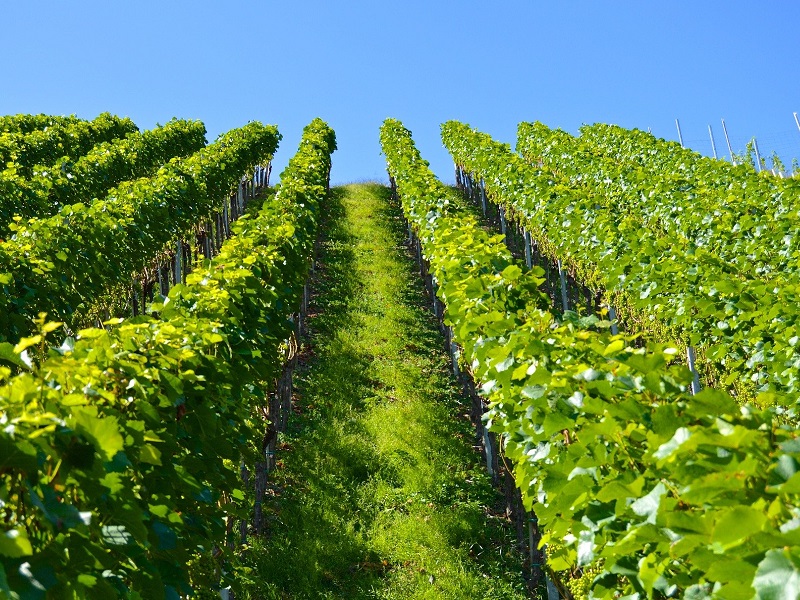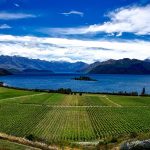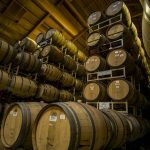Published in the May 2012 issue of the Grapegrower & Winemaker and written by John Whiting, from Victoria’s Department of Primary Industries, the following article offers advice on managing vines after fire damage. It draws on a pilot study conducted in a vineyard Redesdale, near Heathcote in Victoria, after it sustained damage in February 2009.
In recent years, bushfires have impacted on grapegrowing in several states. Climate change projections suggest hotter and drier conditions are likely to increase the risk of annual fire events by 4-25 per cent across southern Australia by 2020 (Hennessy et al. 2005). One consequence of bushfires has been the direct burning of grapevines in vineyards. The effects in vineyard blocks can be patchy and sporadic, making it difficult to undertake research studies. Several instances of grapevine damage and recovery have been reported in the Adelaide Hills and Yarra Valley (Wilkinson and Collins 2010, Scarlett et al. 2011).
Following a fire in a vineyard near Redesdale, Victoria, on 7 February 2009, a pilot study was made on pruning treatments applied to burnt Shiraz vines grafted to 5C Teleki rootstock to assess vine recovery. In addition, this report includes observations on vine recovery in several other blocks in the Redesdale vineyard, as well as observations from a fire in a vineyard at Mafeking in 2006. Any remedial response to direct fire damage to grapevines will depend on the timing and severity of the fire and the value of the grapevines to justify the cost of remedial treatments.
Pruning treatments applied after the fire
In early March 2009, five pruning treatments were applied to one row of vines burnt by a bushfire and observations and measurements made at several stages after that. The level of damage was classed as severe (Figure 1) (see also Scarlett et al. 2011).
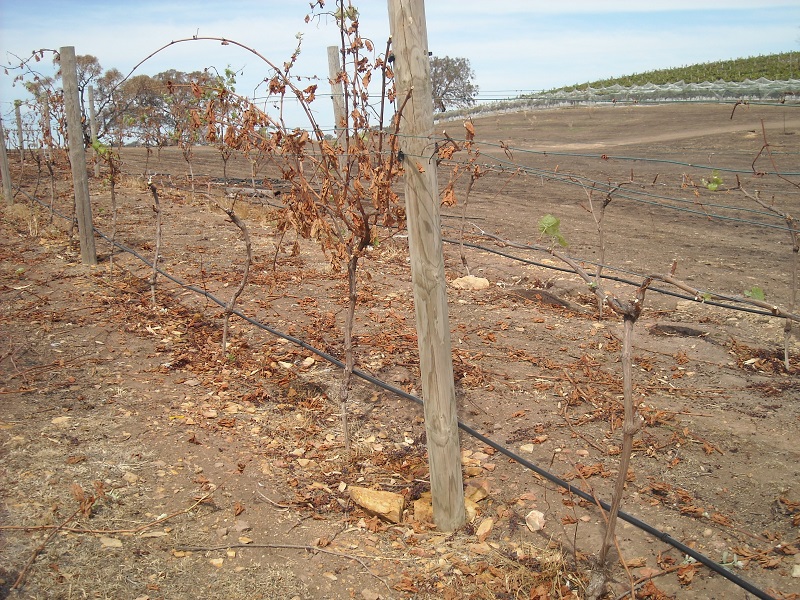
Measurements included the number and length of shoots that grew after the fire, and budburst and fruitfulness assessments in the following season. Several other blocks of vines on the property were also monitored. Vine survival was assessed in several ways based on observation of the canopy after the fire, trunk incision before budburst and assessing vines that made strong and healthy growth in the following season. Bud dissections were also used to assess bud viability and fruitfulness during dormancy.
The vines had previously been cane pruned and the trial pruning treatments were applied about three weeks after the fire. There were five replications of the pruning treatments, which were:
- no pruning (control)
- cordon removed back to a crown, replacement spurs retained (crown)
- cordon retained and shoots pruned to 2-3 node spurs to simulate mechanical pruning (long spurs)
- cordon retained and shoots pruned to short spurs (short spur) t cordon removed and new canes laid down (cane).
The observations and measurements in the Redesdale study were made at three stages: in autumn before leaffall (April 2009), just prior to budburst (September 2009) and just after flowering (December 2009). Data was analysed by two-way analysis of variance.
Results
Severity of fire
The intensity of the fire varied considerably across the vineyard (Figure 1) and even within a block of vines. Generally, the end of the rows and the sides of the vine blocks facing the oncoming fire suffered the greatest. In the Redesdale situation, the fire primarily ran across grassed paddocks into the vineyard. Damage diminished further into the block, where the radiant heat only came from the remaining grass sward between the rows. The leaf and trunk damage observed in the trial row was equivalent to the severe rating described by Scarlett et al. (2011).
April 2009
The vines in the pruning trial were assessed for survival by recording those vines that showed regrowth after the fire. At that stage, 50% of the vines overall showed regrowth and there were no significant differences between the treatments (Table 1). Most of the buds on the control vines remained dormant and where vines were pruned back hard (crown, short spur) a much higher proportion of buds burst. The control treatment produced significantly more shoots per vine than the other four treatments and the long spur treatment produced more shoots than cane pruning. While total shoot length was greatest on the control and long spur treatments, differences were not significant due to high vineto-vine variability.
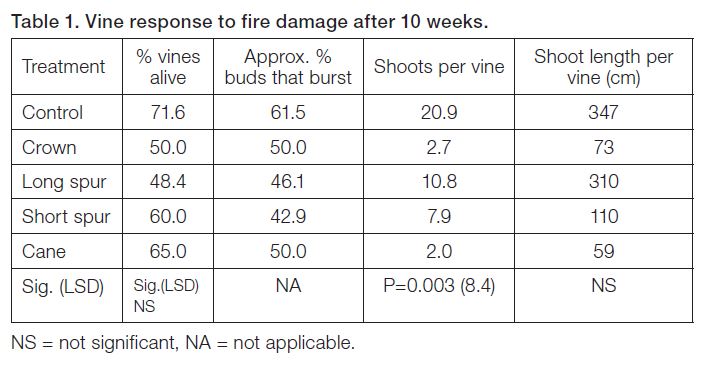
September 2009
Vines were assessed for survival using a trunk incision method similar to Scarlett et al. (2011). An incision was made in the trunk below the graft union. The incision was made with a grafting knife, sufficiently deep enough to expose the cambium, phloem and 1-2mm into the xylem (internal wood). Undamaged tissue remained white or tinged with green and was moist. Damaged tissue was pale yellow to light brown and partially dry, while dead tissue was brown and completely dry (Figure 2). Overall survival was assessed as 51.5% and there were no apparent impacts of pruning treatment on vine survival, similar to the April 2009 assessment.
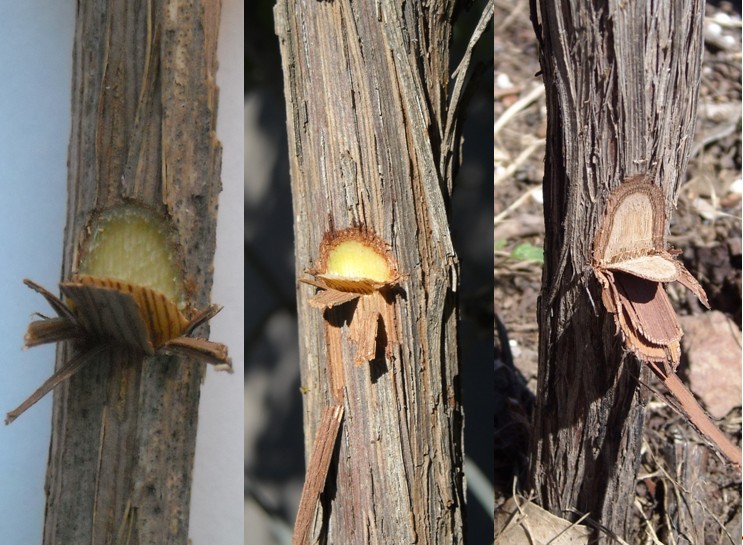
Bud samples from canes that had grown before the fire (old canes) and after the fire (new canes) were collected prior to pruning. These were dissected to assess the viability of primary and secondary buds, along with the presence of inflorescence initials in the primary bud. In the ‘old canes’, 16% of the primary buds were dead and there were, on average, 1.24 inflorescence initials per bud. In the ‘new canes’, 4% of the primary buds were dead but no inflorescence initials were detected. In both ‘new’ and ‘old’ nodes, viable secondary buds were present in all cases.
December 2009
After the September assessment, many vines had been pruned back fairly hard beyond any suspect damaged tissue. Nodes per vine were counted and the only apparent difference was the short spur treatment had more buds retained than long spur (12.9 vs 2.9, respectively). An assessment of vine viability was made after flowering, based on healthy strong growth. Some vines that did not burst or had poor growth had been replaced. The earlier estimates of survival were optimistic compared with the number of vines that were growing healthily in the season following the fire (Table 2). Estimates of survival with the initial observations and trunk incision technique were similar but after budburst in October 2009 some vines grew initially and then collapsed, and others produced very poor growth (Figure 3). All vines that did not look strong and healthy were removed and replaced.
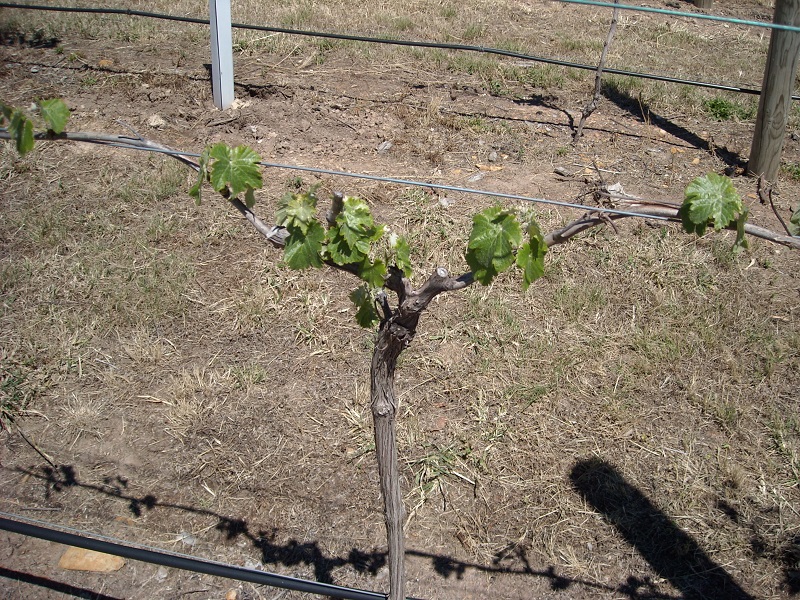
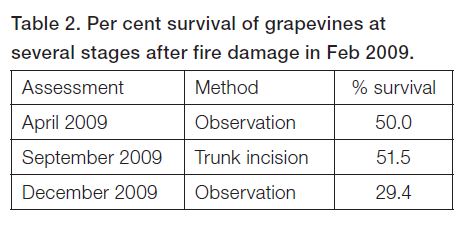
Since more than 70% of the vines had been replaced, it was not feasible to statistically analyse the results. However the control and short spur treatments had the highest shoot number and bunch number per vine. Across all vines that survived, percentage budburst was around 80% and bunch number per node was around 0.53. There were no unburnt vines nearby to compare with but a typical bunch number per vine estimated from a combination of bud numbers per vine, % budburst and bunch numbers per node, would be about 30 bunches per vine. Across all the fire-damaged vines in the trial row bunch number per vine was reduced by an estimated 57-97%.
Other observations
Hard pruning back to basal nodes was implemented in a block of Vermentino vines in the Redesdale vineyard immediately after the fire. Shoots that grew after the fire had inflorescences on them, but by April, they had just flowered and did not produce a viable harvest. During winter pruning, the spurs were pruned to 1-2 node spurs. In December 2009, the regrowth was strong with an average of 1.3 shoots per count node. The shoots that grew were primarily from the post-fire growth and fruitfulness was very low at 0.13 bunches per shoot.
Another block of Shiraz on the property was less affected by fire, with only sporadic leaf desiccation and no post-fire treatments were applied. The vines were cane pruned during the winter and observations in December 2009 showed regrowth was strong (1.1 shoots per count node) and the potential crop (1.6 clusters per shoot) was similar to expectations from non-fire affected vines.
The crop was left on some vines in another block, which incurred minimal fire damage but smoke taint was evident in wine made from the grapes. Within vine-row drip lines were able to be replaced immediately after the fire but other damage to irrigation infrastructure delayed the application of water to the vines.
Discussion
Assessment of fire damage
The visual assessment of vine survival and the trunk incision method showed similar results (about 50% survival), however, both were an over-estimate of vine recovery after budburst in the following season (about 30% survival).
Healthy tissue (left), damaged tissue (middle) and dead tissue (right). Poor regrowth on fire damaged vines in the season following the fire. Scarlett et al. (2011) reported four methods for assessing vine viability after fire but no data was presented to show how well those assessments related to vine survival in the following season.
Based on similar proportions of vines with cambium damage in this work (50%) and in Scarlett et al. (2011) (55%), and the extent of leaf desiccation, all the vines used in the post-fire pruning trial were severely damaged by fire.
Different fire damage situations probably require different damage assessments. After a fire, the first decision is usually whether to retain a block of vines and continue to manage them or to undertake no further management and remove the block.
Retaining a severely damaged block may require the replacement and retraining of many vines – a costly exercise. Above a certain threshold of damage it may be better to clear all the vines and consider replanting the complete block with vines that can be managed all at the same stage of development.
For large blocks of vines with substantial fire damage, mapping the extent of damage by visual inspection followed by trunk staining or trunk incision of a random sample of vines would provide enough information to determine what to do. Scarlett et al. (2011) favoured trunk staining to confirm vine viability but cambium viability determined by trunk incision also correlated well with severity of fire damage. Mapping the damage may lead to a decision to only remove sections of a block to lessen the need for replanting.
On smaller blocks or blocks with more valuable vines, such as heritage vines or special varieties, a vine-by-vine assessment may be required and visual assessment and trunk incision would be preferable. The trunk incision is not destructive and enables the vine to be retained after confirming it is still viable. Conducting this assessment soon after a fire enables an early order to be placed with nurseries about how many vines are needed for replacements, remembering the assessment may be an over-estimate of survival into the following season.
Latent bud analysis immediately after a fire is time consuming and probably not useful in determining whether or not a block of damaged vines should be retained or removed. Collecting the information later in early winter would be useful in determining how to prune fire-affected vines. Even on severely fire-damaged vines many buds are viable and bud analysis at various node positions along the cane would assist in determining the length of bearer (short spur, long spur or cane) that should be retained.
Wilkinson and Collins (2010) reported substantial reductions in shoot and bunch number per vine in the season following fire damage where vines were pruned to two-bud spurs and they suggested longer spurs or cane pruning may be beneficial. However, they did not describe whether the spurs were from wood that had grown before or after the fire. In the current trial shoots arising from post-fire growth had low fruitfulness and those arising from pre-fire growth had reasonable fruitfulness of 1.24 bunches per bud. From a potential cropping aspect there was little difference between spur and cane pruning in the Redesdale trial but this result needs to be tested elsewhere in a more systematic way.
Pruning immediately after fire damage
Growers generally want to consider some form of remedial action, such as pruning immediately after a fire. The results of this trial and other observations would suggest no advantage in cutting vines back and generating fresh growth. New growth relies on stored carbohydrate for the initial growth phase and the short period of subsequent growth is insufficient to replace the carbohydrate in the trunk and roots before the leaves senesce.
No viable crop is produced from the regrowth but this may differ if the fire damage occurs earlier in the season. Even the unpruned vines produced regrowth but some of the carbohydrate used for growth could come from existing canes.
Timing of fire damage
This and other reports (Scarlett et al. 2011, Wilkinson and Collins 2010) studied fire damage occurring in February or March. At that stage of the season, there is insufficient time to ripen any crop produced on the regrowth, nor to produce fruitful buds for use in the following season.
If fire damage occurred earlier, say from November to December, regrowth may have enough time to ripen a crop from secondary buds and to produce fruitful buds for the following season. Fire damage at an early stage of the season would be akin to the regrowth observed with double pruning and provide limited time for the vine to accumulate and store carbohydrate. Hence a decision on whether to apply remedial treatments immediately after a fire may be different if fire occurs earlier.
Fire intensity and response
The intensity of fire can vary considerably across a vineyard or a block of vines, as illustrated in previous articles (Wilkinson and Collins 2010, Scarlett et al. 2011). This results in a wide range of damage to the vines, making it difficult to apply standard remedial treatments across blocks of vines. The ends of rows and sides of blocks facing the fire front have the greatest fire/heat damage whereas heat from a burning slashed interrow sward is low. Flammable under-vine materials, such as straw and hay, exacerbate the heat around the vines and total kill of vines has been observed. Less flammable mulches may create fewer problems. Leaf damage is easily observed (Scarlett et al. 2011) and scorched leaves alone are not usually fatal. However, greater leaf damage reflects greater radiant heat on the cordon and trunk, and it is the superheated cell water in the trunk and cordon that causes tissue damage and decreases the ability of the vines to survive.
It is the level of fire intensity that will determine any recovery after the vines have been burnt. Low intensity fire damage (minimal leaf desiccation, no trunk damage) appears to have little effect on growth and fruitfulness in the following season and no post-fire pruning is required.
Medium intensity fire damage (incomplete leaf desiccation, some secondary budburst after the fire, minimal trunk damage) also appears to have minimal effect on budburst in the following season but there may be a reduction in fruitfulness. Some vines may have more internal damage than expected and they may grow poorly or collapse in the following season. No post-fire pruning is required.
High intensity fire damage (complete leaf desiccation, numerous secondary budburst after fire, obvious trunk damage) is usually sustained where the fire front hits a vineyard and from the burning of dense grass and/or straw mulch applied along the vine row. If a substantial amount of trunk damage has occurred, the vines are unlikely to survive and no remedial treatment can be justified. If the damage is extensive across a block, complete removal and replanting is an option. If the trunk is only partially damaged (>50% trunk viability), vines could be left unpruned or pruned back to short spurs.
Conclusions
The variability of fire damage encountered in this pilot study with uncontrolled fire has made it difficult to be conclusive about remedial actions. Seasonal timing and the intensity of the event will both affect the potential damage to the vine. A better assessment of grapevine response to fire damage could be made by controlled burning of vines, perhaps with a system of gas burners. For low and medium intensity fire damage, remedial pruning after the fire is not justified and vine survival is likely to be high and crop reductions in the following year minimal. High intensity fire damage can kill vines and if the proportion of dead vines is high, a decision will be required on the value of attempting to rejuvenate the surviving vines versus removing all vines and replanting.
References
Hennessy K, Lucas C, Nicholls N, Bathols J, Suppiah R and Ricketts J (2005) Climate change impacts on fire-weather in south-east Australia. Consultancy report by CSIRO Marine and Atmospheric Research, Bushfire CRC and Australian Bureau of Meteorology, http://www.cmar.csiro.au/e-print/open/ hennessykj_2005b.pdf.
Scarlett N, Needs S and Downey MO (2011) Assessing vineyard viability after bushfire. Aust. NZ Grapegrower Winemaker 564:21-25.
Wilkinson K and Collins C (2010) Grapevine recovery following fire damage. Aust. NZ Grapegrower Winemaker 556:42-43
This article was originally published in the Grapegrower & Winemaker in May, 2012.
Watch this space for more updated information.
